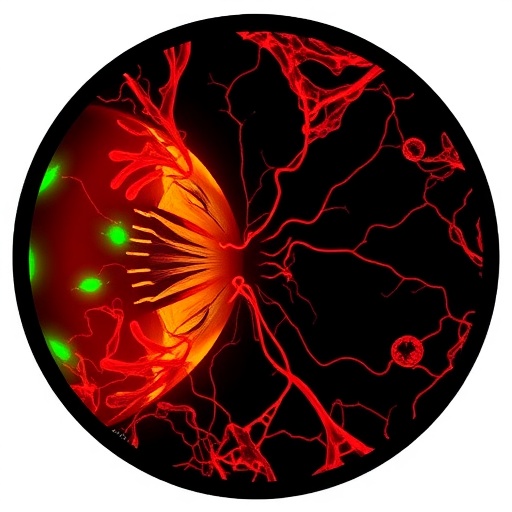In the realm of healthcare research, a new study has emerged that sheds light on the intricate relationship between systemic inflammation and diabetic retinopathy in patients suffering from type 2 diabetes mellitus. This condition is characterized by chronic high blood sugar levels that lead to a host of complications, one of the most concerning being diabetic retinopathy—a condition that can lead to vision loss. The research, conducted by Bulut and Keser, is a prospective cross-sectional study that investigates the connection between the pan-immune inflammation value (PIV) and various stages of diabetic retinopathy.
Chronic inflammation is known to play a significant role in the progression of many diseases, particularly those associated with metabolic syndromes. The PIV is a novel marker, integrating multiple facets of immune response and inflammation into a singular measure. This study articulates how elevated levels of this marker can correlate with worsening stages of diabetic retinopathy among individuals diagnosed with type 2 diabetes. Such findings could revolutionize how practitioners approach early detection and management of diabetic retinopathy.
Existing literature has long recognized that diabetes is accompanied by a state of low-grade systemic inflammation. However, the specifics of how this inflammation translates into ocular complications have remained less defined. The research team embarked on this study with a hypothesis that high PIV levels would equate to an increased severity of diabetic retinopathy. The hope was to furnish clinicians with a tool to assess risk more effectively and perhaps intervene before irreversible damage occurred.
The study’s methodology involved the recruitment of a diverse cohort of patients diagnosed with type 2 diabetes from various outpatient clinics. Each participant underwent thorough clinical evaluations, including retinal imaging to determine the stage of diabetic retinopathy. Additionally, blood samples were taken to measure the pan-immune inflammation value alongside other traditional markers of inflammation, such as C-reactive protein (CRP) and interleukins.
Intriguingly, the results of the study were compelling. A clear gradient emerged, showing that as the PIV increased, the stages of diabetic retinopathy advanced accordingly. For instance, patients with mild non-proliferative diabetic retinopathy exhibited lower PIV levels compared to those with moderate or severe stages. This finding reinforces the concept that systemic inflammation does not merely coexist with diabetes but actively contributes to its complications.
Furthermore, the researchers did not just stop at identifying this relationship; they delved deeper into the underlying mechanisms of how inflammation mediates retinal health. Previous studies have established that the retina is not only affected by local factors but also by systemic conditions. The vascular changes induced by inflammatory mediators can result in the leakage of fluid and the formation of microaneurysms, both hallmark signs of diabetic retinopathy.
The inclusion of PIV as a routine assessment could pivotally change the landscape of diabetic care. By utilizing a marker that reflects the immune system’s ongoing battle with inflammation, healthcare providers might be able to classify patients according to risk and customize management plans accordingly. This could entail earlier referrals for ophthalmological evaluation, aggressive glycemic control, and lifestyle interventions aimed at reducing inflammation.
However, transitioning from findings to clinical practice necessitates further research. The authors advocate for longitudinal studies that encompass diverse populations and varying degrees of diabetes management. Long-term studies could illuminate the predictive capabilities of PIV and solidify its place in the clinical workup of diabetic patients.
Moreover, the advent of personalized medicine means that markers such as PIV could help in tailoring therapeutic options for individual patients. If validated, treatments targeting inflammation could emerge as a pivotal focal point in mitigating the progression of diabetic retinopathy, sparing patients from the futility of vision loss.
As with all scientific inquiries, the study by Bulut and Keser is but a stepping stone in unraveling the complexities surrounding diabetic complications. The juxtaposition of immune response, systemic inflammation, and vascular health encapsulates the multi-faceted nature of diabetes management. The findings implore the medical community to look beyond glucose levels and consider inflammation as a pivotal player in the diabetic trajectory.
Ultimately, the relationship between pan-immune inflammation value and stages of diabetic retinopathy forms a critical area of focus for future investigations. It offers hope for patients and clinicians alike: a new frontier in understanding, preventing, and potentially reversing one of the most challenging complications of diabetes. As the body of evidence grows, the implications of such research could catalyze a paradigm shift in how diabetic retinopathy is approached globally, encouraging a more integrated model of care that encompasses systemic health.
The urgency of addressing diabetic retinopathy, given its prevalence and the devastating impact of exudative retinal disease, cannot be understated. Each discovery propels researchers closer to strategies that can reduce incidences, aid early detection, and arms healthcare providers with the knowledge necessary to thwart the march toward blindness in diabetic populations. The journey towards a comprehensive understanding of the relationship between inflammation and retinopathy is not just academic; it is profoundly human, affecting millions around the world.
As diabetes continues to rise to epidemic proportions, so too must our commitment to discovering innovative solutions. The implications of Bulut and Keser’s study may well have far-reaching effects, propelling new dialogues in ophthalmology and endocrinology and ultimately altering the outcomes for countless individuals grappling with the specter of diabetes.
Subject of Research: The relationship between pan-immune inflammation value and different stages of diabetic retinopathy in patients with type 2 diabetes mellitus.
Article Title: The relationship between pan-immune inflammation value and different stages of diabetic retinopathy in patients with type 2 diabetes mellitus: a prospective cross-sectional study.
Article References:
Bulu, A., Keser, S. The relationship between pan-immune inflammation value and different stages of diabetic retinopathy in patients with type 2 diabetes mellitus: a prospective cross-sectional study.
BMC Endocr Disord 25, 184 (2025). https://doi.org/10.1186/s12902-025-02007-x
Image Credits: AI Generated
DOI: 10.1186/s12902-025-02007-x
Keywords: diabetic retinopathy, type 2 diabetes, pan-immune inflammation value, inflammation, systemic health.




